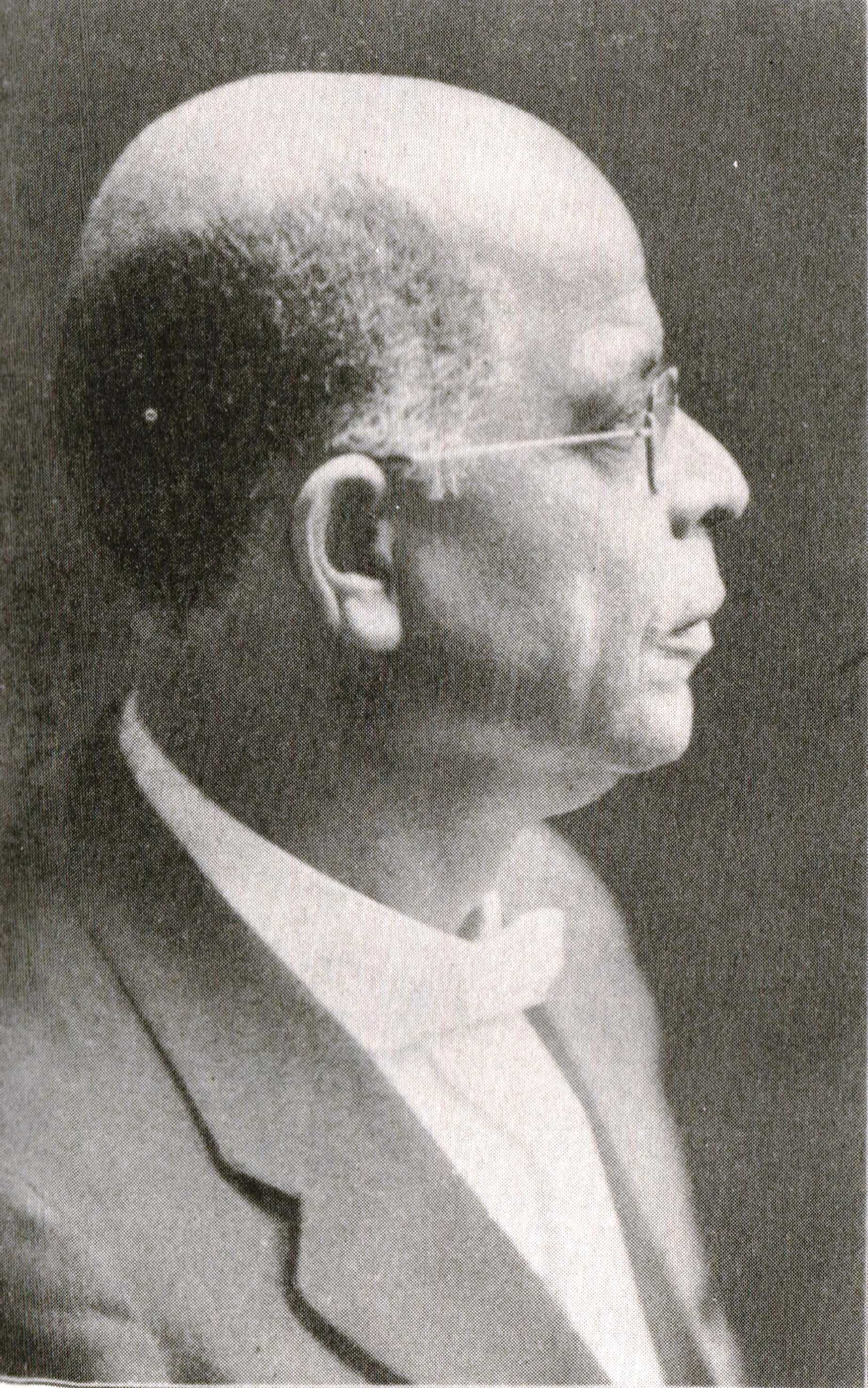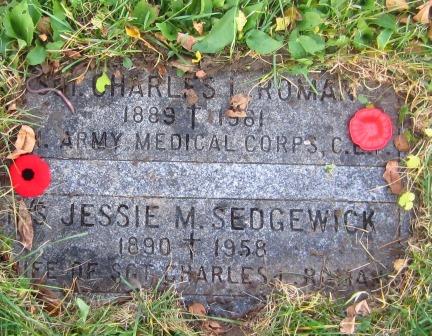Charles Lightfoot Roman, MD, CM, surgeon, author, researcher, lecturer (born 19 May 1889 in Port Elgin, ON; died 8 June 1961 in Valleyfield, QC). Charles Lightfoot Roman was one of the first Black Canadians to graduate from McGill University’s Faculty of Medicine and became a recognized expert in industrial medicine. He was also one of the first Black Canadians to enlist for service in the First World War and was the only known Black person to serve with the Canadian General Hospital No. 3 (McGill). Lightfoot Roman was also likely the first Black Grand Master of a traditional Masonic lodge.

Family Background
Charles Lightfoot Roman was the grandson of a fugitive slave, James William Roman, who had made his way from Maryland to Canada via the Underground Railroad. James married Anne Walker McGuinn, the daughter of runaway slaves. The couple lived in Williamsport, Pennsylvania, for a number of years where James captained a riverboat. He transported lumber down the Susquehanna River to Chesapeake Bay, then, as a sponsor on the Underground Railroad, returned upriver while hiding fugitive slaves in the hold of the boat.
Around 1870, the couple returned with their children to Canada and settled on the McGuinn farm in Burford, Ontario. In 1876, the family moved to Dundas, Ontario. There, James and one of his sons, also named James (Charles Lightfoot’s father), sold brooms to the local cotton mill and townspeople. Another son, Charles Victor, began work in the mill at age 12. When he was 17, Charles Victor suffered a tragic accident in the mill that resulted in the amputation of his right leg. He would eventually move to the United States, where he became a highly respected physician and surgeon with specialties in ophthalmology and otolaryngology.

Charles Lightfoot Roman’s father, James, was in his twenties when he too left the Hamilton region. James moved to Port Elgin, then a booming port town on the shores of Lake Huron, where he found employment in the local broom factory.
Early Life
James Roman briefly returned to Dundas, Ontario, to marry Fannie Lightfoot on 1 May 1888. He then brought her to live in Port Elgin. A year later, on 19 May 1889, Fannie gave birth to a son, Charles Ferdinand Roman (he later replaced Ferdinand with his mother’s maiden name). The couple eventually had three other children — Etta, Anniebel and John.
In the early 1890s the family moved to Bay City, Michigan, about 160 km from Detroit. James was hired by the Bay City Broom Factory (as he had been born in Williamsport, Pennsylvania, he could live and work on both sides of the border). His son, Charles Lightfoot Roman, therefore grew up in Bay City, where he attended elementary and secondary schools.
Education
Charles Lightfoot Roman had been named after his uncle, the surgeon and professor of medicine, Dr. Charles Victor Roman. After graduating from high school in 1907, young Charles followed his uncle’s lead and travelled to Nashville, Tennessee, to attend university. He enrolled at Fisk University, right across the street from Meharry Medical College, where his uncle was a professor of medicine. In 1910, he graduated from Fisk University with a Bachelor of Science Degree.

Lightfoot Roman stayed in the southern United States and taught for a year before returning to Canada in 1912, to enrol in McGill University’s Faculty of Medicine. When he began his medical studies at McGill, he was fulfilling his uncle’s dream — Charles Victor Roman had originally planned to attend medical school at McGill University but had lacked the necessary funds and ended up in Tennessee instead.
With the onset of the First World War, Lightfoot Roman put his studies aside to enlist with the Canadian General Hospital (CGH) No.3 on 18 February 1915.
War and Romance
Charles Lightfoot Roman was one of the original members of the Canadian General Hospital, No. 3 (McGill). When he enlisted on 18 February 1915, he became one of the first Canadian Blacks to sign up in the First World War and the only Black person known to have served with the CGH No. 3 (McGill). (See also Black Volunteers in the Canadian Expeditionary Force.) At the time he enlisted, Lightfoot Roman had finished only three of the five years required to complete his medical training at McGill, so he began his service as an orderly with the rank of Private.
On 6 May 1915, he boarded the RMS Metagama, bound for Europe. On board the ship was his future wife, nursing sister Jessie Middleton Sedgewick, who was also serving with CGH No. 3.

Another member of the hospital team was assistant quartermaster Lieutenant Edward Osler, son of renowned Canadian doctor, Sir William Osler. Lightfoot Roman later mentioned Osler in a letter he wrote to celebrated neurosurgeon and author Dr. Harvey Cushing on 4 May 1926. In reference to Cushing's Pulitzer Prize–winning biography, The Life of Sir William Osler, Lightfoot Roman wrote that “it was my privilege to know Sir William Osler’s son, a high-minded gallant gentleman who served in the same unit with me (No.3 Canadian General Hospital).”
On 16 May 1915, the McGill hospital team arrived in Shorncliffe, England. About a month later, on 19 June 1915, they reached Dannes-Camiers, France, and began setting up camp. (Nursing Sister Sedgewick and the other nurses from Montréal assisted the Canadian General Hospital No. 1 near Étaples until their own unit became operational, about one month later.)
The CGH No. 3 operated in huge Durbar tents that had been shipped from India. Unfortunately, storms and floods battered the tents, causing many of them to leak, and during a later inspection a number of them were condemned. On 25 October, another storm tore through the facility, leaving many of the remaining tents in tatters. As a result, some of the staff were assigned to work at other stations and hospitals (this included Nursing Sister Sedgewick, who was temporarily reassigned to work with the CGH No. 1).
Ironically, Lightfoot Roman had spent most of his time in France until that point (from July to mid-October) sick in hospital. However, by the middle of October 1915 he had rejoined the CGH No. 3 as an orderly. Lightfoot Roman and the rest of the McGill medical team continued to work in Dannes-Camiers until January 1916, when they moved further north to Boulogne-sur-Mer on the coast of France. Here, the hospital was housed at the old Jesuit College — rather than operating in tents, the staff now worked in permanent or wooden structures. Lightfoot Roman would spend the rest of his time in France at Boulogne.
Lightfoot Roman’s future wife, Nursing Sister Sedgewick, also served at Boulogne with the CGH No. 3 from 14 February 1916 until 11 August 1917. She appears in the war diary of Nursing Sister Clare Gass, who wrote that she “walked today in afternoon hours off, by upper Boulogne Road west & south to Camiers (about seven miles I should think) with Ruth and Jessie Sedgewick.”
Although we know little about the wartime romance between Lightfoot Roman and Sedgewick, their military relationship is clear. As a private and then corporal, Lightfoot Roman was outranked by Sedgewick, who as a nursing sister was a commissioned officer (Lieutenant). This continued to be the case even after Lightfoot Roman was promoted to the rank of Sergeant on 17 April 1917. Gass made reference to this hierarchy in her diary when she wrote that, “one of the doctors at the McGill Hospital observed that some of the nurses were rather'picayune' in commanding male medical students — mere sergeants — to do the sweeping.”
Lightfoot Roman served 25 months in France and by the end of his service, was a Wardmaster in the CGH No. 3. In 1917, he returned to Canada, following the government’s decision that all medical and dentistry students who had completed at least one year of training should finish their studies. In June 1917, Colonel Birkett stated in the official military diary that, “two of my medical students No. 477 Sgt. Wienke and No. 439 Sgt. Roman C. L. having successfully completed three years of a five years [ sic] course at McGill University Montreal Canada returned to England en route to Canada with a view to resuming their studies.”
In 1919, Lightfoot Roman graduated as a Doctor of Medicine and Master of Surgery (MD, CM) from McGill University. He and Jessie Middleton Sedgewick married on 25 December 1920 and eventually settled in Valleyfield, Québec. The couple would have five sons — Charles, James, William Middleton, Robert and Stephen. Jessie Roman died 20 July 1958. In her memory, her husband commissioned a stained glass window to be mounted in the United Church attended by the family. Its inscription reads, “Her own works praise her in the gates” (Proverbs 31:31), a tribute to her dedication as a nurse and a mother. (In 2008, the church was converted to Le MUSO, a museum in Salaberry-de-Valleyfield. The window remains intact.)

Did you know?
Another notable Black sergeant in the CEF was Dominique François Gaspard. Like Lightfoot, Gaspard was a medical student when the war broke out. He left his studies at the Montreal branch of Université Laval (later renamed Université de Montréal) and volunteered for overseas service. Gaspard served at No. 4 Stationary Hospital in Saint-Cloud, a French-Canadian field hospital in France that was staffed by volunteers from Université Laval. In 1917, Gaspard returned to his studies. He established a general medical practice in Montreal and became a trailblazer in the city’s Black district.
Medical Practice
Following his graduation from McGill University in 1919, Lightfoot Roman took on a number of duties for the Montreal General Hospital, including that of house surgeon. In addition, he was senior resident, admitting officer and acting medical superintendent for the hospital until 1921.
Lightfoot Roman continued to be influenced by the life of his uncle and namesake, Charles Victor Roman. His decision to pursue a career in industrial medicine was likely influenced by the work-related amputation suffered by his uncle. In 1921, Lightfoot Roman became one of the first industrial medicine doctors in Québec when he took up a position as physician for Montreal Cottons Limited (a division of the Dominion Textile Company) in Valleyfield. His wife, Jessie, worked as a nurse alongside him. He eventually rose to the position of medical director for the entire corporation and remained at Dominion Textile for the rest of his career, retiring shortly before his death in 1961.
Author, Researcher and Lecturer
Charles Lightfoot Roman became an acknowledged expert in the field of industrial medicine. He applied his experience with Dominion Textile to advancing knowledge in what is now known as occupational medicine and wrote several articles on such subjects as"Severe Industrial Injuries to the Fingers and their Treatment" (Canadian Medical Association Journal Volume 13, September 1923). He also researched the evolution of health and safety for cotton mill workers, publishing his findings in a paper titled “Some Reflections Upon the Health and Mortality of Cotton Textile Workers” (Canadian Medical Association Journal Volume 55, October 1946).
Like his uncle, Charles Victor Roman, Lightfoot Roman was also a lecturer, speaking across North America on the practice and objectives of industrial medicine.
One of the earliest practitioners of industrial medicine in Canada, Lightfoot Roman was honoured in Los Angeles as a Fellow of the Industrial Medical Association in 1953. The association (originally known as The American Association of Industrial Physicians and Surgeons) had been founded in 1915, only six years before Roman began practicing industrial medicine.
Masonic Association
Charles Lightfoot Roman’s achievements extended beyond medicine. He was initiated into the Valleyfield Lodge, No. 75 of the Freemasonry on 28 March 1923 and was elected as Worshipful Master in 1929. In 1934, he became District Deputy Grand Master for Montreal District No. 3. His service over several years earned him the distinction of Honorary Member of several lodges in Québec. He was also a frequent speaker at the Masonic Study Club of Montréal.
In October 1950, Lightfoot Roman began a two-year term as the elected Deputy Grand Master of the Grand Lodge of Québec and in October 1952 became Grand Master. When he was elected Grand Master, he likely became the first Black to head a traditional or mainstream Grand Lodge in North America (i.e., a Grand Lodge founded on and adhering to the original laws and principles of Free Masonry). Other notable Canadian Masons include Thayendanegea Brant, Sir Sanford Fleming, James Naismith, Robert Service, and several prime ministers (e.g., Sir John A. MacDonald).
Significance
Dr. Charles Lightfoot Roman died 8 June 1961 and was laid to rest at the National Field of Honour in Pointe-Claire, Québec. His life had been one of service — to his country, his faith, and to his fellow men and women. When Lightfoot Roman enlisted on 18 February 1915 with the Canadian General Hospital No. 3 (McGill) he was among the first Black Canadians to sign up for service in the First World War. One of the first Black Canadians to graduate from McGill University’s Faculty of Medicine, he became a well-known expert in industrial medicine. According to Masonic historian Dr. Wallace McLeod, it is also likely that Lightfoot Roman was the first Black Grand Master of a traditional Masonic lodge.
Following Lightfoot Roman’s death, the presiding Grand Master paid tribute to the “Most Worshipful Brother Roman,” when he delivered his annual address before members of the Grand Lodge. He praised Roman’s “attitude towards the practice of medicine as being not only a profession but a way of life. … He was more than a doctor to his patients, he was a warm friend and counsellor to them, and their families … as a man, as a physician and as a Mason he was an exemplary individual.”

Acknowledgements
A great deal of collaboration and research was required to complete this biography. Our thanks to the Roman family (particularly Cindy, Snake River and David Roman), Anna Dysert (Osler Library, McGill University), Mathieu Tremblay (Musée de société des deux-rives), Dr. Wallace McLeod (Professor Emeritus, University of Toronto), Elmer Anderson (Retired Minister, Dundas Baptist Church), Alan Smith, and Ken and Louise Lyons.

 Share on Facebook
Share on Facebook Share on X
Share on X Share by Email
Share by Email Share on Google Classroom
Share on Google Classroom






